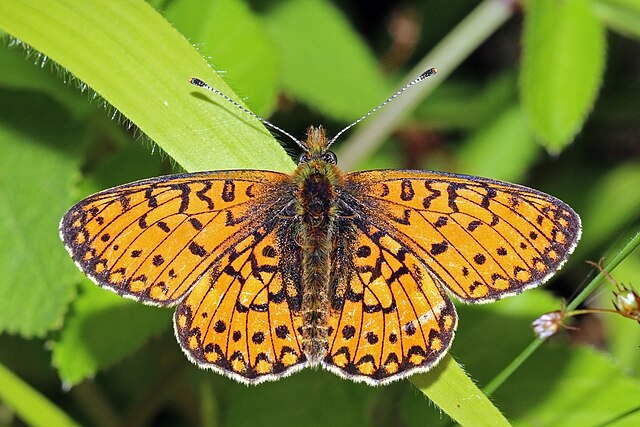Loading AI tools
Largest butterfly family From Wikipedia, the free encyclopedia
The Nymphalidae are the largest family of butterflies, with more than 6,000 species distributed throughout most of the world. Belonging to the superfamily Papilionoidea, they are usually medium-sized to large butterflies. Most species have a reduced pair of forelegs and many hold their colourful wings flat when resting. They are also called brush-footed butterflies or four-footed butterflies, because they are known to stand on only four legs while the other two are curled up; in some species, these forelegs have a brush-like set of hairs, which gives this family its other common name. Many species are brightly coloured and include popular species such as the emperors, monarch butterfly, admirals, tortoiseshells, and fritillaries. However, the under wings are, in contrast, often dull and in some species look remarkably like dead leaves, or are much paler, producing a cryptic effect that helps the butterflies blend into their surroundings.
| Nymphalidae | |
|---|---|
 | |
| Scientific classification | |
| Domain: | Eukaryota |
| Kingdom: | Animalia |
| Phylum: | Arthropoda |
| Class: | Insecta |
| Order: | Lepidoptera |
| Superfamily: | Papilionoidea |
| Family: | Nymphalidae Rafinesque, 1815 |
| Subfamilies | |
and see article text | |
| Diversity | |
| Over 600 genera About 5,700 species | |





Rafinesque[1] introduced the name Nymphalia as a subfamily name in diurnal Lepidoptera. Rafinesque did not include Nymphalis among the listed genera, but Nymphalis was unequivocally implied in the formation of the name (Code Article 11.7.1.1). The attribution of the Nymphalidae to Rafinesque has now been widely adopted.[2]
In the adult butterflies, the first pair of legs is small or reduced,[3] giving the family the other names of four-footed or brush-footed butterflies. The caterpillars are hairy or spiky with projections on the head, and the chrysalids have shiny spots.
The forewings have the submedial vein (vein 1) unbranched and in one subfamily forked near the base; the medial vein has three branches, veins 2, 3, and 4; veins 5 and 6 arise from the points of junction of the discocellulars; the subcostal vein and its continuation beyond the apex of cell, vein 7, has never more than four branches, veins 8–11; 8 and 9 always arise from vein 7, 10, and 11 sometimes from vein 7 but more often free, i.e., given off by the subcostal vein before apex of the cell.[4]
The hindwings have internal (1a) and precostal veins. The cell in both wings is closed or open, often closed in the fore, open in the hindwing. The dorsal margin of the hindwing is channelled to receive the abdomen in many of the forms.[4]
The antennae always have two grooves on the underside; the club is variable in shape. Throughout the family, the front pair of legs in the male, and with three exceptions (Libythea, Pseudergolis, and Calinaga) in the female also, is reduced in size and functionally impotent; in some, the atrophy of the forelegs is considerable, e.g., the Danainae and Satyrinae. In many of the forms of these subfamilies, the forelegs are kept pressed against the underside of the thorax, and are in the male often very inconspicuous.[4]
The phylogeny of the Nymphalidae is complex. Several taxa are of unclear position, reflecting the fact that some subfamilies were formerly well-recognized as distinct families due to insufficient study.
The five main clades within the family are:[5]
The libytheine clade (basal)
The danaine clade (basal)
The satyrine clade
The heliconiine clade (sister group of the nymphaline clade, excludes former tribes Biblidini and Cyrestini, and tribes Pseudergolini and Coeini)
The nymphaline clade (sister group of the heliconiine clade, also includes tribes Coeini and Pseudergolini)
The trait for which these butterflies are most known is the use of only four legs; the reason their forelegs have become vestigial is not yet completely clear. Some suggest the forelegs are used to amplify the sense of smell, because some species possess a brush-like set of soft hair called setae, which has led researchers to believe the forelegs are used to improve signaling and communication between the species, while standing in the other four. This ability proves useful in terms of reproduction and the overall health of the species, and it is the leading theory so far.[7]
Seamless Wikipedia browsing. On steroids.
Every time you click a link to Wikipedia, Wiktionary or Wikiquote in your browser's search results, it will show the modern Wikiwand interface.
Wikiwand extension is a five stars, simple, with minimum permission required to keep your browsing private, safe and transparent.